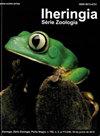Reproductive success of Trypoxylon (Trypargilum) lactitarse (Hymenoptera: Crabronidae) in a fragmented landscape
IF 0.5
4区 生物学
Q4 ZOOLOGY
引用次数: 3
Abstract
ABSTRACT Fragmentation of natural vegetation often implies a reduction in local species richness and abundance. The resources used by bees and wasps for feeding and nesting are distributed quite irregularly in fragmented environments, which influences their foraging behavior, occurrence patterns and reproductive success. The objective of the present work was to determine if the size of native vegetation remnants influences the reproductive success of the solitary wasp species Trypoxylon (Trypargilum) lactitarse Saussure, 1867. Trap-nests were established along the edges of forest fragments of different sizes located in municipalities in the central region of the state of Goiás, Brazil. The nests were used to quantify nesting rate, number of cells with larvae, survival of larvae, proportion of nests attacked by parasitoids, and size of hatched adults. The foundation rate of trap-nests was greater in large fragments, whereas the mean number of cells per nest, parasitoidism rate, larval survival and sex ratios, and size of hatched adults did not differ between large and small fragments. Therefore, it appears that fragment size influences the survival or permanence of adults more so than it does that of the larvae in the studied fragments. There are two possible explanations for the difference in the foundation rate: 1) each female founds, in average, the same number of nests in small and large fragments, but the number of females is lower in the smaller fragments; 2) females have the capacity to provision several nests, but in the larger areas each female founds more nests than in smaller areas. However, it is necessary future studies to differentiate these two hypotheses.碎化景观中拟姬蜂(膜翅目:姬蜂科)的繁殖成功
自然植被的破碎化往往意味着当地物种丰富度和丰度的减少。蜜蜂和黄蜂用于觅食和筑巢的资源在碎片化环境中分布非常不规则,这影响了它们的觅食行为、发生模式和繁殖成功率。本研究的目的是确定原生植被残余的大小是否会影响独居黄蜂的繁殖成功率。在巴西Goiás州中部各市不同大小的森林碎片边缘建立了陷阱巢。通过对巢内产卵率、幼虫细胞数、幼虫存活率、被寄生蜂攻巢比例和孵化成虫大小进行量化。大片段的陷阱巢建立率较高,而大片段和小片段的陷阱巢平均细胞数、寄生率、幼虫存活率和性别比以及孵化成虫的大小没有差异。因此,碎片大小对成虫的生存或持久性的影响似乎比对所研究碎片中幼虫的影响更大。筑巢率的差异可能有两种解释:1)每只雌鸟在小碎片和大碎片上平均筑巢数量相同,但在小碎片上雌鸟数量较低;2)雌性有能力提供多个巢穴,但在较大的区域,每只雌性比在较小的区域建立更多的巢穴。然而,有必要在未来的研究中区分这两种假设。
本文章由计算机程序翻译,如有差异,请以英文原文为准。
求助全文
约1分钟内获得全文
求助全文
来源期刊

Iheringia Serie Zoologia
生物-动物学
CiteScore
1.00
自引率
0.00%
发文量
12
审稿时长
6-12 weeks
期刊介绍:
The journal Iheringia, Série Zoologia, edited by the “Museu de Ciências Naturais” of the “Fundação Zoobotânica do Rio Grande do Sul”, publishes original research findings in zoology with emphasis on taxonomy, systematics, morphology, natural history, and community or population ecology of species from current Neotropical fauna. Scientific notes will not be accepted for publication. Species lists without a taxonomic approach, or that are not the result of studies on the ecology or natural history of communities will not normally be accepted. The same applies to identification keys of groups of taxa defined by political boundaries. Authors wishing to inquire about the scope of the journal or the suitability of a particular topic are encouraged to contact the Editorial Board prior to submission. Furthermore, articles with a main focus on agronomy, veterinary, zootechny or other areas involving applied zoology will not be accepted.
Its abbreviated title is Iheringia, Sér. Zool., which should be used in bibliographies, footnotes and bibliographical references and strips.
 求助内容:
求助内容: 应助结果提醒方式:
应助结果提醒方式:


